|

On eBay Now...
Antique reliquary relic True Cross Jesus,Apostles,Saints,Martyrs + Document 1826 For Sale
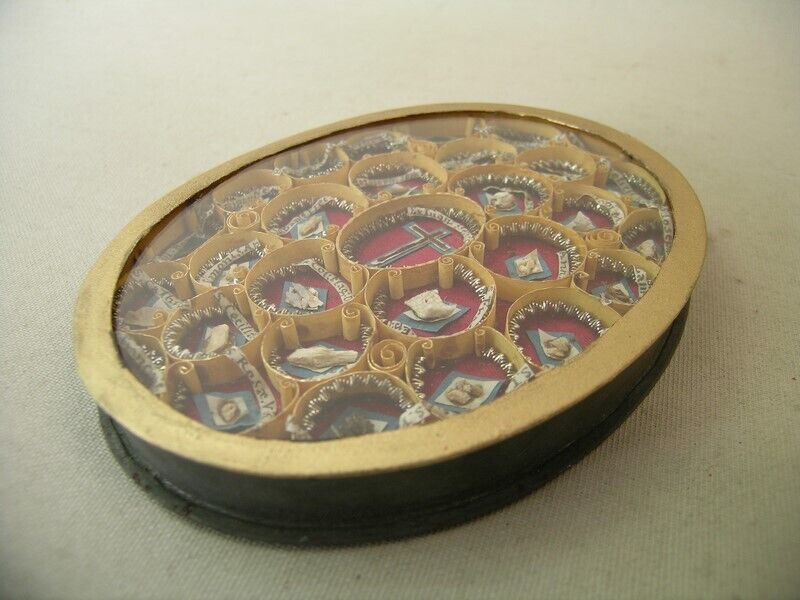
When you click on links to various merchants on this site and make a purchase, this can result in this site earning a commission. Affiliate programs and affiliations include, but are not limited to, the eBay Partner Network.

Antique reliquary relic True Cross Jesus,Apostles,Saints,Martyrs + Document 1826:
$1450.00
This is a metal thecawith (painted) front, inside more than 20 relics.All relic in place and wax sealintact, only the threads are broken (the metal is very sharp and the threadsare very thin). Comes with its original document signed in 1826.The documentwas in the back of the pendant, so its wrinkled and it has some tears.The relicare from : the True Cross of our Lord Jesus, ex Praesepe D.N.J.C (from theNativity) ex Colomna Flagellation D.N.J.C (from the column of Flaggelation), expalio St Joseph, Sepulcro B.M.V (from the grave of the virgin Mary), Saint Anne(mother of the virgin Mary), Saint John the Baptist, The Apostles Peter, Jamesthe Lesser, Simon, Andrew, and Paul, Saint Camillis de Lelis, Saint CharlesBorromeo, Saint Francis de Sales, Saint Lawrence of Rome, Saint Stephen the Martyr, Saint Francis de Chantal, Saint Philip Neri, Saint Pascal Baylon, Saint Joseph of Cupertino, SaintCatharina.Vid, Saint Bridget of Sweden, Saint Frances of Rome, Saint Cecillia, Saint Jerom,Saint Felix of Cantalice, Saint Chrispinus,Saint John of the Cross, SaintRose of Viterbo. Comes from a convent inItaly. 3,6x4,6 inch.Shipping and handling US$ 27,00by insured priority mail and tracking number. All my items are securely packet,to avoid all possible damage. Our Non Paying Buyer process is nowautomatically managed by . Theprocess starts four days after sale end and closes as soon as payment isreceived. As per policy,this reliquary does not contain human remains but only objects ofdevotion. Please be carefull when buying relics online. Fakerelics are increasingly more and more of a problem. Most of the relics I sellare from convents in Belgium and Italy. I have been collecting relics for morethan 25 years. I consider myself an expert. Please contactme if you have any questions. Please contact me if you have any questions. Itemscannot be returned! Please see my other salesfor more antique catholic items The MostHoly Wood of theCross of Our Lord Jesus Christ According to several Church historians of the 4th and5th century, the True Cross was discovered in 325 AD when Emperor Constantinethe Great ordered the removal of a pagan temple built by Hadrian over the siteof the Calvary and the Holy Sepulchre. Beneath the structure, in an oldcistern, three crosses, the title with the inscription \"Jesus of Nazareth,King of the Jews\", and three nails were found. In the presence of theEmpress Helena, mother of Constantine, the Cross of Christ was identified bythe \'titulus\' and the nail holes, and later confirmed by a miracle. It was laidupon a sick woman who was immediately miraculously cured. Helena divided the most precious wood into severalparts, leaving a fragment in Jerusalem, sending a second to her son inConstantinople and taking a third to Rome. A part of it and half of the titlewith the inscription I NAZARINUS R... is still preserved and venerated in theBasilica di S. Croce, one of the seven main churches of the Eternal City. In1998, a careful investigation was commissioned by the Holy See and sevenIsraeli expertson the dating of inscriptions (comparativepalaeography)dated its letters into the 1st century, the time of Christ.This suddenly gave the \'legend of the Finding of the Cross\' a lot ofcredibility. Already in 349 AD, St. Cyril, bishop of Jerusalem,stated that the True Cross \"has been distributed, fragment by fragment,from this spot (Jerusalem) and has already nearly filled the world\",confirming the early practise of distributing tiny particles of the Most HolyWood. When St. Paulinus of Nola sent one to a friend in ca. 401 AD, he wrote:\"Receive a great gift in a little case and take this segment as anarmament against the perils of the present and a pledge of everlastingsafety\". He stressed that \"even the smallest particle bears in it thewhole power of the Cross of Christ\". The claim of the \"enlightened\" sceptics,that all relics of the True Cross would be sufficient to build a ship, wasproven wrong in 1870 by the French scholar Rohault de Fleury, whomathematically calculated the volume of all relics of the True Cross in allEuropean Cathedrals and found them all together having the mass of only onethird of a Roman cross! Saint Peter the Apostle Also known as - Cephas
- First Pope
- Keipha
- Kepha
- Pre-eminent Apostle
- Prince of the Apostles
- Shimon Bar-Yonah
- Shimon Ben-Yonah
- Simeon
- Simon
- Simon bar Jonah
- Simon ben Jonah
- Simon Peter
Memorial - 29 June(feastof Peter and Paul)
- 22 February(feastof theChair of Peter, emblematic of the world unity of the Church)
- 1 August(Saint Peter in Chains)
- 18 November(feastof the dedication of the Basilicas of Peter and Paul)
Profile Born Died - crucifiedhead downward because he claimed he was not worthy to die in the same manner as Christ
Canonized Name Meaning Patronage - against feet problems
- against fever
Saint James the Lesser Also known as - Jacobus Minor
- James the Just
- James the Less
- James the Younger
- James, son of Alphæus
- James, the brother of the Lord
Memorial - 3 May
- 1 May(under the titleJames, son of Alpheus; Anglican)
- 9 October(Orthodox asJames, son of Alpheus)
- 23 October(Luther Church in America asJames the Just; Orthodox asJames the Righeous)
- 26 December(Eastern Orthodox)
Profile Cousin of Jesus. BrotherofSaintJude Thaddeus. Raised is a Jewish home of the time with allthe training in Scripture and Law that was part of that life.Convert. Oneof the Twelve Apostles. One of the first to have visions of the risen Christ.FirstBishopofJerusalem. Met withSaintPaul theApostleto work outPaul‘s plans forevangelization. Supportedthe position that Gentileconvertsdid not have to obey all Jewishreligious law, though he continued to observe it himself as part of hisheritage, may have been a vegetarian. A just and apostolic man known forhisprayerlife and devotion to thepoor.Martyr. Having been beatentodeath, a club almost immediately became his symbol. This led tohispatronageoffullersandpharmacists, both of whomuse clubs in their professions. He is reported to have spent so much timeinprayerthat his knees thickened, and looked like a camel’s. Soonafter theCrucifixion, James said he would fast until Christ returned; theresurrected Jesus appeared to him, and fixed a meal for James Himself. Died - c.62atJerusalemby being thrown from a pinnacle of the Temple, then stoned andbeatenwith clubs, includingfuller‘s mallets, whileprayingfor his attackers
- relicsenshrinedin theBasilicaof the Holy Apostles inRome,Italy
Canonized Patronage - against pain
- dying people
- apothecaries
- druggists
- fullers
- hatmakers
- hatters
- milliners
- pharmacists
- wool carders or combers
Saint Simon the Apostle Also known as - Nathanael of Cana
- Simon Kananaios
- Simon Kananites
- Simon the Cananean
- Simon the Zealot
- Simon Zealotes
Memorial - 28 October(Roman Church)
- 10 May(Coptic Church)
- 30 June(Orthodox)
Profile Apostle. Called theCananeanorZealotbecause of his zeal forthe Jewish law; he was not fromCana, nor a member of theZealotparty. Like alltheApostles, he was aconvert, and was trainedbySaintPeter thoughthere are traditions of him being in several other locations. He wasamartyrfor thefaith, but several places claim to have beenthe site ofthat, too. Died - Abyssiniansclaim he wascrucifiedinSamaria
- Lipsius says he was sawn in half at Suanir,Persia
- Moses of Chorene writes that he wasmartyredat Weriosphora in Iberia
- many locations claim to haverelicsincludingToulouse,France, andSaint Peter’s Basilica,Rome,Italy
Canonized Patronage - curriers
- fishermen
- sawmen
- sawyers
- tanners
- woodcutters
- Cartigliano,Italy
- Marostica,Italy
- Monterchi,Italy
- Worshipful Company of Shipwrights
Saint Andrew the Apostle Also known as - Andrew the Protoclete
- Andreas….
- Endres….
Memorial - 30 November
- 9 May(translation ofrelics)
- 13 December(Ukraine)
Profile The firstApostle.Fishermanbytrade. Brother of SimonPeter. Follower ofJohn the Baptist. Andrewwent through life leading people to Jesus, both before and aftertheCrucifixion.MissionaryinAsia MinorandGreece,and possibly areas in he is said tohavepreachedfor two days from it. Somepeculiarmarriage-related superstitions have attached class=\"MsoNormal\" style=\"margin-left: 72pt; text-align: justify; text-indent: -18pt; line-height: 19.2pt; background-image: initial; background-position: initial; background-size: initial; background-repeat: initial; background-attachment: initial; background-origin: initial; background-clip: initial;\">·AnoldGermantradition says that singlewomenwho wishtomarryshould ask forSaintAndrew’s help on the eve ofhisfeast, then sleep naked that night; they will see their futurehusbands in their dreams. ·Another says thatyoungwomenshould note the location ofbarkingdogsonSaintAndrew’s Eve: their future husbandswill come from that direction. ·On the day afterAndrew’sfeast,young peoplefloat cups in a tub; ifaboy‘s and agirl‘s cup drift together and are intercepted by a cupinscribed “priest”, it indicates marriage. There are severalexplanations for why Andrew became thepatronofScotland. ·In345,EmperorConstantine the Greatdecided to translate Andrew’s Scotlandwas instructed by anangelto take many oftheserelicsto the far northwest. He was eventally told to stop onthe Fife coast ofScotland, where he founded the settlement of SaintAndrew. ·In the7thcentury,SaintWilfrid of Yorkbrought some ofthesaint‘srelicswith him afterapilgrimagetoRome,Italy. TheScotsking,Angus MacFergus, installed them at Saint Andrew’s to enhance the prestige ofthe newdiocese. ·WhenthePictishKingAngus faced a large invadingarmy,heprayedfor guidance. A white cloud in the form of asaltirecrossfloated across the blue sky above him. Angus won a decisive victory,and decreed that Andrew would be thepatron saintof his country.Following Robert Bruce’s victory at theBattle of Bannockburnin1314, theDeclaration of ArbroathofficiallynamedSaintAndrew thepatron saintofScotland. The Saltire became thenational flag ofScotlandin1385. Born Died - crucifiedon asaltire(x-shaped)crossin PatrasGreece
- relicsdestroyed c.1559by Protestants
Patronage - against cramps
- against convulsions
- against dysentery
- against fever
- against gout
- against neck pain, stiff neck or torticollis
- against paralysis
- against sore throats
- against whooping cough
Saint Paul the Apostle Also known as - Apostle Paul
- Apostle to the Gentiles
- Paul of Tarsus
- Saul of Tarsus
Memorial - 25 January(celebration of hisconversion)
- 10 February(SaintPaul Shipwrecked)
- 29 June(celebration ofSaintPeterandSaintPaul as co-founders of theChurch)
- 18 November(feast of the dedication of theBasilicasof Peter and Paul)
Profile Born - c.3at Tarsus, Cilicia (modern Turkey) asSaul
Died - Canonized
Patronage - against hailstorms
- against poisonous snakes
- against snake bites
- against snakes
- Catholic Action
- Cursillo movement(confirmed byPopePaul VI)
- Gentiles
- lay people
- Worshipful Company of Fruiterers
SaintLawrence of Rome Also known as - Laurence
- Laurent
- Laurentius
- Lorenço
- Lorenzo
Memorial Profile Lawrence’scare for thepoor, theill, and the neglected have led tohispatronageof them. His work to save the material wealth oftheChurch, including its documents, broughtlibrariansandthose in related fields to see him as apatron, and to ask for hisintercession. And his incredible strength and courage when being grilledtodeathled to hispatronageofcooksand thosewho work in or supply things to the kitchen. The meteor shower that follows thepassage of the Swift-Tuttle comet was known in the middle ages as the “burningtears ofSaintLawrence” because they appear at the same time asLawrence’sfeast. Born Died - cooked to deathon a gridiron on10 August258inRome,Italy
- tradition says that the ashes of his burned body were dispersed by the winds, and appear at different places around the world on hisfeastday
- buriedin the cemetery ofSaintCyriaca on the road toTivoli,Italy
- tomb was later opened by Pelagius to inter the body ofSaintStephen the Martyr
- his mummified head isenshrinedat the Quirinal Chapel of the Vatican Apostolic Library inRome
- otherrelicsand the gridiron believes to have been his deathbed areenshrinedin the crypt of the Basilica of San Lorenzo Outside the Walls,Rome
- his garments areenshrinedin Our Lady’s Chapel in the Lateran Palace,Rome
Patronage - against fire
- against lumbago
- archives
- archivists
- armories
- armourers
- bibliophiles, book lovers, book collectors
- brewers
- butchers
- charcoal burners
- chefs, cooks
- comedians
- comediennes
- comics
- confectioners
- cutlers
Saint Charles Borromeo Also known as - Apostle to theCouncil of Trent
- Carlo Borromeo
- Father of the Clergy
Memorial - 4 November
- formerly5 November
- 3 November(Milan,Italy)
Profile Bornto a wealthy, noble family, the third ofsixchildren, sonofCountGiberto II Borromeo and Margherita de’ Medici. NephewofPopePius IV. Suffered with a speechimpediment.StudiedinMilan, and at theUniversityofPavia,studyingatone point under the age21.ClericatMilan, taking San Felino e San GrazianoabbeyinArona,Italy,on20 November1547.Abbotcommendatarioof San Silanodi San Maria diCalvenzanoabbeyon8 December1558. Protonotary apostolicparticipantium and referendary of thepapalcourt toPopePiusIVon13 January1560. Member of thecounsultafor the administration of thePapalStateson22 Nonatola, San Gallo di Moggio,Serravalle della Follina, San Stefano del Corno,anabbeyinPortugal, and Createdcardinalon31January1560at age 22. Apostolicadministrator for two years beginning on26April1560.Deaconon21 December1560. VaticanSecretary of State.GovernorofCivita Made an honorary citizenofRome,Italyon1 July1561. Founded theAccademia September1563. Helpedre-open theCouncil of Trent,and participated in its sessions during1562and1563.Namedprinceof Orta in1563. Member of theCongregation of the Holy Office.BishopofMilanon7December1563. President of the commissionoftheologianscharged by thepopeto elaborate theCatechismus Romanus. Worked on the revision oftheMissalandBreviary. Member of a commission to the patriarchalLiberianbasilicainRomein October1564.Countofthe Palatine in1564. Prefect of theTridentine Romandiola,legatealatere, and August1565. Grand penitentiary on7November1565. Participated V; he asked the newpopeto take the name.Protector of theSwissCatholiccantons; he visited them allseveral times worked for the spiritual reform of bothclergyandlaymen.Due to his enforcement of strict ecclesiastical discipline, somedisgruntledmonksin theOrderof the Humiliatihired alay brotherto murder him on theevening of26 October1569; he was shot at, but was not hit.Participated in theconclavein1572thatchosePopeGregory XIII. Member of theApostolic Penitentiaryin May1572. Worked withthesick, and inMilanin1576. EstablishedtheOblates of Saint giving him hisfirstcommunionon22July1580. To help theSwissCatholicshe founded theCollegium Helveticum. SaintCharlesspent his life and fortune in the service of the people of hisdiocese. Hedirected and fervently enforced the decrees of theCouncil of Trent, fought tirelessly for peace in the wake of thestorm caused byMartin Luther, conducted synods, institutedchildren‘s Sunday school, didgreat public and private penance, and worked amongthesickanddying, leading his people by example. Born - morning of Wednesday2 October1538in the castle at Aron,dioceseofNovara,Italy
Died - 8:30pm on3 November1584of afeveratMilan,Italy
- his will named the Hospital Maggiore ofMilanas his heir
- buriedin themetropolitancathedralofMilan
- relicstransferred to achapelbuilt byCountRenato Borromeo in piazza San Maria Podone,Milanon21 September1751
Beatified Canonized - 1 November1610byPopePaul V
Patronage - against abdominal pain
- against colic
- against intestinal disorders
- against stomach diseases
- against ulcers
- apple orchards
- bishops
- catechism writers
- catechists
- catechumens
- clergy
Saint Stephen the Martyr Also known as Memorial - 26 December
- 3 August(discovery ofrelics)
- 7 May(translation ofrelics)
Profile Died Canonized Name Meaning - crown(from the phrasecrownofmartyrdom)
Patronage - against headaches
- against migraines
- altar servers
- brick layers
- builders; construction workers
- casket makers
- coffin makers
- deacons
- horses
- masons
- quarrymen
- stone masons
- weavers
Saint Pascal Baylon Also known as Memorial Profile Sonof the piouspeasantsMartin Baylon and Elizabeth Jubera. From youthhe displayed great devotion to theEucharist. Worked asashepherdfrom ages 7 to 24, and was a good influence onhisshepherdfriends, an often rowdy group.Franciscanlaybrotherwith friars of theAlcantarineReform, often serving ascookordoorkeeper.Hischarityto thepoorandafflicted, his unfailingcourtesy and humility were remarkable even he defended the Real Presenceagainst the blasphemies of aCalvinistpreacher, and narrowlyescapeddeathat the hands of aHuguenotmob.Poorlyeducated, he was still a counselor sought by richandpooralike. Hiscultusis especially stronginSpainand southernItaly, inCentralandSouthAmerica. Born - 24 May1540(feastofPentecost) at Torre Hermosa,Aragon, (modernSpain)
Died - 15 May1592(feastofPentecost) at Villa Reale,Spainof natural causes
Beatified - 29 October1618byPopePaul V
Canonized - 16 October1690byPopeAlexander VIII
Patronage - cooks
- Eucharistic congresses, confraternities and organizations(proclaimed byPopeLeo XIIIon28 November1897)
- shepherds
- Bisenti,Italy
- Saint Joseph of Cupertino
Also known as - Giuseppe da Copertino
- Joseph Desa
- Joseph of Copertino
- the Flying Friar
- the Gaper (derogatory term from hischildhood)
Memorial Profile Joseph’sfather,Felice Desa was apoorcarpenterwhodiedbefore theboywasborn. Creditors drove hismother, Francesca Panara, from her home, andJoseph was born in a stable. Starting at age eight, he received ecstaticvisions that left him gaping and staring into space. He had a hot temper, whichhis strictmotherworked to overcome. Apprenticedtoashoemaker. At age 17 Joseph applied for admittance to theFriarsMinor Conventuals, but was refused due to his lack ofeducation. Heapplied to theCapuchins, was accepted asalay-brotherin1620, but hisecstasiesmade himunsuitable for work, and he was dismissed. Abused by his family, he continuedhisprayers, and was accepted as Hisvirtues were such that he became aclericat 22,apriestat 25. Joseph still had littleeducation, could barelyread or write, but received such a gift of spiritual knowledge and discernmentthat he could solve intricate questions. Hislife became a series of visions andecstasies, which could be triggeredany time or place by the sound of a churchbell, churchmusic, themention of the name ofGodor of theBlessed Virginor ofasaint, any event in the life of Christ, the sacred Passion, a holypicture, the thought of the glory in heaven, etc. Yelling, beating, pinching,burning, piercing with needles – none of this would bring him from his trances,but he would return to the world on hearing the voice of his superior in theorder. He would oftenlevitateand float (which led tohispatronageof people involved inair travel), and could hearheavenlymusic. Evenin the17th century, there was interest in the unusual, andJoseph’secstasiesin public caused both admiration and disturbancein the community. For 35 years he was not allowed to attend choir, go to thecommon refectory, walk in procession, or sayMassin church. Toprevent making a spectacle, he was ordered to remain in his room with aprivatechapel. He was brought before the Inquisition, and sent fromoneCapuchinorFranciscanhouse to another. But Josephretained his joyous spirit, submitting to Divine Providence, keepingsevenLentsof 40 days each year, never lettinghisfaithbe shaken. Born - 17 June1603at Cupertino,dioceseofNardo, nearBrindisiin the kingdom ofNaples,Italyas Joseph Desa
Died - 18 September1663atOssimo,Italyof a rapidly developed but severefever
- buriedin the Crypt of the Sanctuary, Church of Saint Francis,Ossimo
Beatified - 24 February1753byPopeBenedict XIV
Canonized - 16 July1767byPopeClement XIII
Patronage - air crews
- Air Forces
- air travellers
- aircraft pilots
- astronauts
- aviators
- flyers
- paratroopers
- students
- test takers
Saint Bridget of Sweden Also known as - Bridget of Vadstena
- Bridgit…
- Birgit…
- Birgitta…
- Bridgid…
- Brigida…
- Brigetta…
Memorial - 23 July
- formerly8 October
Profile Daughterof Birger Persson, thegovernorand provincialjudgeofUppland, and of Ingeborg Bengtsdotter. Herfatherwas one of thegreatest landowners in the country, hermotherwas known widely forher piety, and the family were descendants of theSwedishroyalhouse. Related toSaintIngrid of Sweden. Bridgetbegan receiving visions, most of theCrucifixion, at age seven.Hermotherdiedc.1315when thegirlwas abouttwelve years old, and she was raised andeducatedby an equally piousaunt. In1316, at age thirteen, Bridget wedprinceUlfo ofNercia in an arrangedmarriage. She wasthemotherofeight, includingSaintCatherine ofSweden; some of the otherchildrenignored theChurch. Friendand counselor to manypriestsandtheologiansof her day.Chief lady-in-waiting toQueenBlanche of Namur in1335, fromwhich position she counseled and guidedtheQueenandKingMagnus II. AfterUlfo’sdeathin1344following apilgrimagetoSantiago deCompostela,Spainshe pursued areligious life,for which she was harassed by others at thecourt. She eventuallyrenounced her andmysticalwriter. She recorded the revelations givenher in her visions, and these became hugely popular in the Middle Ages. FoundedtheOrder of the Most Holy Savior(Bridgettines) atVadstena,Swedenin1346. It received confirmationbyPopeBlessedUrban Vin1370, and survives today,though few houses remain.PilgrimtoRome, toassortedItalianholy sites, and to the Holy Lands. Chastened andcounseledkingsandPopesClement VI,Gregory XI,andUrban VI, urging each to return toRomefromAvignon.Encouraged all who would listen to meditate on the Passion, and of JesusCrucified. Born - 1302or1303at Finsta Castle, Uppsala,Sweden
Died - 23 July1373atRome,Italyof natural causes
- buriedin1374at the Vadstena,Swedenconventshe had founded
Canonized - 7 October1391byPopeBoniface IX
Patronage - Europe(proclaimed on1 October1999byPopeJohn Paul II)
- Sweden
- widows
Saint Rose of Viterbo Also known as - Rose of Vieterbo
- Rosa of….
Memorial - 6 March
- 4 September(translation ofrelics; class=\"MsoNormal\" style=\"text-align: justify; line-height: 19.2pt; background-image: initial; background-position: initial; background-size: initial; background-repeat: initial; background-attachment: initial; background-origin: initial; background-clip: initial;\">Profile
Franciscantertiary.At age three she brought a person back fromdeath.Preachedinthe streets from age ten and led public processions praising Christ. Prophetessand subject to visions. Had the friendship ofbirds. Was repeatedlyrefused entrance to thePoor Clares, and in1250shewasexiledfor supporting thepopeagainst Frederick II.After herdeath,PopeAlexander IVordered her body laid torest in theconventthat had refused her. Born - Died
- 6 March1252of natural causes
Canonized Patronage - exiles
- people rejected by religious orders
- tertiaries
Saint Frances of Rome Also known as - Franziske av Rome
- Francesca Bussa de’ Leoni
- Francesca Romana
Memorial Profile Bornto the aristocracy, the daughter of Paul Bussa and Jacobella de’Roffredeschi.Marriedat age twelve to Lorenzo de’ Ponziani;hermarriagelasted 40 years.Motherof threein1400,1404, and1407.Widow. Benedictine.Foundress of theOblates of theTor de’ Specchi(Collatines).Said to have been guided by anarchangelonly she could see. Spenther life and fortune, both aslaywomanandreligious, in theservice of thesickand thepoor, including the founding of thefirst home inRomeforabandonedchildren. Dictated97Visions, in which shesaw many of the pains of Hell. Onherfeast daypriestsblesscars due toherpatronageof cars anddrivers. Frances certainly neverdrove, but legend says that when she went abroad at night,herguardianangelwent before her, lighting the road with aheadlight-like lantern, keeping her safe in hertravels. Born - 1384inRome,ItalyasFrancesca Bussa de’ Leoni
Died - 1440inRome,Italy
- relicsat Saint Frances of Rome Church,Rome,Italy
- entombedbeneath the pavement of the Ponzianisacristyof the Church of Saint Cecilia,Rome,Italy
Canonized Patronage - against plague
- automobile drivers, motorists(proclaimed byPopePius XIIon9 September1951)
- automobilists
- Benedictine Oblates
- aviators
- cab drivers, taxi drivers
- death of children
- lay people
- motorcyclists
SaintFelix of Cantalice Also known as - Ass of theCapuchins(his own nickname for himself)
- Brother Deo Gratias (“Deo Gratias” was his habitual greeting)
- Felix of Catalicio
- Felix of Cantalica
- Felice Porri
- Feliks z Cantalice
Memorial Profile Bornto piouspeasants, he was ashepherdin hisyouth. At agenine he was hired out as ashepherdandfarm handat CottaDucale; he worked there over twenty years. A piousyouthand man,Felix spent his free time inprayer. Havinglittleeducation, Felix had a friend read him the lives of the earlyDesert Fathers; they left him torn – he wanted to live as ahermit, butfeared he would give in to temptation if he had no superior. He sought entranceto theCapuchins; they were hesistant, but finally accepted him asalay toRomein1547as questor for the community; hestayed there the rest of his life. Felix’sreputation for holiness spread quickly. He could not even read,yettheologiansconsulted him on spiritualality and Scripture.Sinners on the street would hide from him when it became obvious he could seetheir sins, and knew their hearts. Felixpreachedin the street,rebuked corrupt politicians and officials, and exhorted young men to stopleading dissolute lives. Once during Carnival, a time of open vice in thestreets, Felix andSaintPhilip Neriorganized a processionofCapuchinfriars right into the middle of the revellers; Fra Lupo,a well-knownCapuchinpreacher, spoke to the crowds, and Carnivalended for the year. Felixworked with thechildrenofRome; his inherent simplicity and lackof education made him rather childlike, andchildrentrusted him. Hecomposed simpleteachingcanticles, and hadthechildrengather in groups to sing them as a waytoteachthemcatechism. Thecanticlesbecamewell-known and popular, and while Felix was begging for hishouse,Romancitizens would invite him in to sing for them; he sawthese invitations as opportunities toteach, and always jumped at them. Duringthefamineof1580, the city fathers askedtheCapuchinsfor the loan of Felix as a fund raiser; he was tirelessin the work. His friend,SaintPhilip Neri, considered Felix thegreatest saint then help to draw up the constitutionsof theOblates of Saint Ambrose;Philipreferredhim to Felix as a the best advisor. Felixslept little, ate what came to hand, attendedMassevery morning. Hehad a great devotion toOur Lady,frequentlyprayedtherosary, and was sometimes swept awayinecstacy, unable to finish theprayers. Received a vision of theVirginMaryduring which he was allowed to hold the Christ Child in his arms.Acclaimed asaintby the people ofRomeimmediately afterhisdeath. Born - 18 class=\"MsoNormal\" style=\"text-align: justify; line-height: 19.2pt; background-image: initial; background-position: initial; background-size: initial; background-repeat: initial; background-attachment: initial; background-origin: initial; background-clip: initial;\">Died
- 18 May1587atRome,Italyof natural causes
- so many came to his funeral that some were injured in the press to get into the church, and an extra door had to be knocked through one wall so they could exit
- buriedunder analtarin the church of theImmaculate ConceptioninRome
- miraclesreported at his tomb
Beatified - 1 October1625byPopeUrban VIII
Canonized - 22 May1712byPopeClement XI
Patronage Saint Jerome Also known as - Eusebius Hieronymus Sophronius
- Girolamo
- Hieronymus
- Jerom
- Man of the Bible
Memorial - 30 September
- 15 June(Eastern calendar)
- 9 May(translation ofrelics)
Profile Bornto a richpaganfamily, Jerome led a wild and misspentyouth.StudiedinRome,Italy,and became alawyer. Heconvertedand joined theChurchintheory, and wasbaptisedin365, but it was only when he beganhisstudyoftheologythat he had a trueconversionandthefaithbecame integral to his life. Hebecame amonk, then, needing isolation for his study of Scripture, helived for years as ahermitin theSyriandeserts. There heis reported to have drawn a thorn from alion‘s paw; theanimalstayedloyally at his side for years. Priest.Student ofSaintGregory of Nazianzen.SecretarytoPopeDamasusIwho commissioned Jerome to revise the Latin text of the Bible. Theresult was 30 years of work which we know as theVulgatetranslation, the standard Latin version for over amillenia, and which is still in use today. Born Died - 419of natural causes
- interredin Bethlehem
- relicsat the Basilica of Saint Mary Major inRome,Italy
Canonized Patronage - archeologists
- archivists
- Bible scholars
- librarians
- libraries
- scholars
- schoolchildren
- students
- translators


Rare Antique French Travel Reliquary, Boxwood, sacred Heart Ste Félicité 1860's $235.00
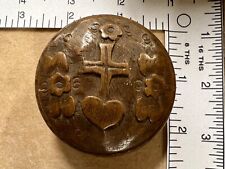
Antique French Travel Reliquary, Boxwood carved top, Honore, Agnus Dei, 1880's $240.00
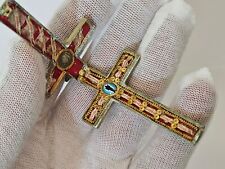
ANTIQUE CROSS RELIQUARY BOX RELIC PENDANT RELICS SAINT APOSTLES RARE ( BK99 ) $245.00
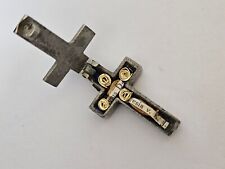
ANTIQUE RELIC CROSS RELIQUARY BOX PENDANT RELICS SAINT APOSTLES ( BK106 ) $59.00

Antique Saint Reliquary $300.00

ANTIQUE CROSS RELIQUARY BOX RELIC PENDANT RELICS SAINT APOSTLES RARE ( BK100 ) $165.00
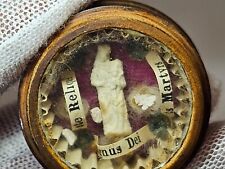
ANTIQUE RELIQUARY BOX RELICS SAINT APOSTLES RELIC ICON VERY RARE (No.ЮQ89) $130.00

ANTIQUE CROSS RELIQUARY BOX RELIC PENDANT RELICS SAINT APOSTLES RARE ( BK45 ) $175.00
|